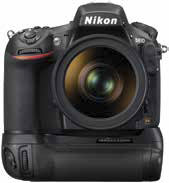articles/Cameras/nikon-d810-page4
Nikon D810 - part 4 of 1 2 3 4 5 6
by Mike McNamee Published 01/02/2016

What sharpening will never do is make a fundamentally poorly crafted image into a silk purse! Given that you have to come off the fence and do something here is a distillation of the Pixel Genius method; the method is described into detail by Jeff Schewe in his book The Digital Print, along with a cogent explanation of why.
- Judging sharpness must be done on a print, at the finished size.
- Pre-sharpening (which he calls Capture Sharpening) is performed in Adobe Camera Raw with settings chosen from this table.
- For 'Sunday Best' a luminance mask is made and this is adjusted so that an edge-enhanced version is used to sharpen edges and an inversion of it is used to reduce noise* in the flat areas of tone.
Two possibilities are suggested for the final print output sharpening,
one is a High Pass method** and the other is the new Photoshop Smart
Sharpen. Both are used selectively on detected edges within the image.
The use of sharpened layers and de-noised layers allows both to be
finessed via the opacity slider.
*It is worth noting that in five years of using a Nikon D700 we never
once adjusted an image for noise reduction - it never seemed to be
required or worth the effort.
Making a luminance mask
- In the Channels palette click the 'Load Channels as a selection' icon.
- Rename the new Alpha 1 channel 'Luminosity' then deselect the active selection.
- Apply the Find Edges filter to the Luminosity channel then use levels to clip the black side of the histogram.
- Blur the Luminosity Channel using Gaussian blur at 3 pixels.
- Invert the Luminosity channel then use Levels to clip the highlights in the channel.
- This mask is now prepared for sharpening the detected edges in the image as below.
Using the Luminosity Mask - Smart Sharpen Workflow
- Make two copies of the background layer and rename one 'Sharpen Edges' and the other 'De Noise'.
- Ctrl-Click the Luminosity Channel to load it as a selection, then on the Sharpen Layer click the 'Make a Mask' icon.
- Ctrl Click on the Luminosity layer then click on the De Noise layer, then click the 'Make a Mask' icon, then, with the mask active, hit Ctrl-I to invert the mask.
- Click on the De Noise layer itself then use Filter>Noise>Reduce noise and set the panel up as below. We applied full noise reduction even on this low ISO shot because it can be controlled with the opacity of the layer at a later stage.
You now have a sharpened layer and a noise-reduced layer each with a mask which attends to the areas in the image where they are required. The opacity of the sharpening may have to be backed off, we chose 60%, to reduce any halos or artefacts.
Please Note:
There is more than one page for this Article.
You are currently on page 4
- Nikon D810 page 1
- Nikon D810 page 2
- Nikon D810 page 3
- Nikon D810 page 4
- Nikon D810 page 5
- Nikon D810 page 6
1st Published 01/02/2016
last update 21/07/2022 08:46:25
More Cameras Articles
There are 30 days to get ready for The Society of Photographers Convention and Trade Show at The Novotel London West, Hammersmith ...
which starts on Wednesday 14th January 2026










